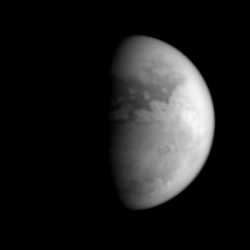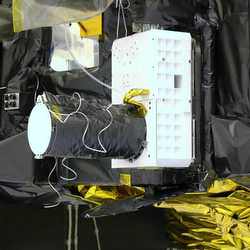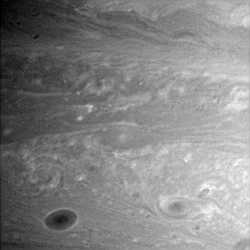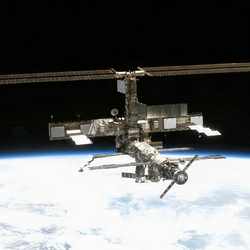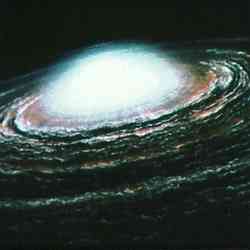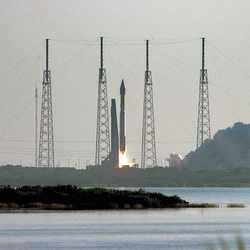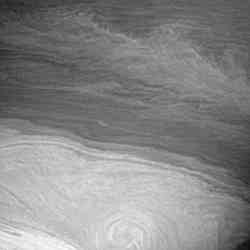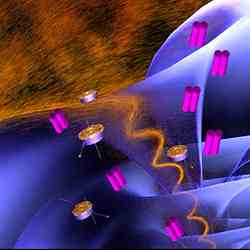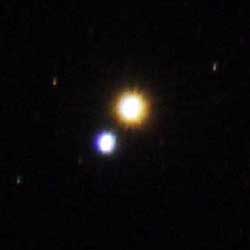
Credit: Randy Brewer
Monday, August 15 – With the constellation of Cygnus now reaching the upper third of the eastern skyline, tonight would be the perfect opportunity for us to look at a summer favourite – Albireo. As the second brightest star in Cygnus, you can locate it easily by looking slightly more than a fist’s width below (east) Vega, and about a handspan roughly south of Deneb. Your best results for color will be at minimum power for telescopes and even a steady hand with binoculars can split this pair. Now let’s have a look at this beautiful double star!
With a wonderfully rich field as a setting, you will find the third magnitude primary star to be very golden in color – a true K3 spectrum type. The secondary is close to fifth magnitude and is definitely tinged blue as its B8 V class suggests. First logged by F.W.G. Struve in 1832, they are believed to be a true physical pair although no orbital motion has yet been detected. At around 410 light years away, the primary star shows a composite spectrum and is in itself a double star too close to be split telescopically. While you look at this pair, realize their true separation is about 4400 AU. We could place our solar system, end-for-end, 55 times in this amount of “space”!
Now let’s turn our attention towards the Moon.
If you are using binoculars, tonight’s study feature will be the easy C-shape of Sinus Iridium. Known as the “Bay of Rainbows”, this 160 mile wide circular plain may very well be the result of an impact on the edge of Mare Imbrium. For telescope users, continue south to the western shore of Mare Cognitum and look along the terminator for the Riphaeus Mountains. This is the largest remainder of mare’s wall.
Tuesday, August 16 – Tonight let’s start with lunar observations and features that can be seen with both binoculars and telescopes. Just slightly north of center along the terminator, look for the bright point of Kepler. Watch as this 20 mile wide feature develops a bright ray system in the coming days. To the north you will see equally bright Aristarchus. Only about 5 miles wider, Aristarchus is quite probably one of the youngest of the prominent features – around 50 million years old – and will also develop a ray system.
Now let’s head south to the sunny shores of Mare Humorum and have a look at a much older feature – the graceful Gassendi. Making its home on the northern edge of a mare that’s around the size of the state of Arkansas, this class V crater will appear as a bright ring to binoculars, but take on special beauty in the telescope. While most of its south wall has almost disappeared thanks to lava flows, the ancient Gassendi still holds an impressive central triple mountain peak and a wonderful collection of rilles and ridges along its floor.
Wednesday, August 17 – Tonight let’s start by observing our western planets as they begin drawing nearer to each other. For the northern hemisphere, you will find Venus very low just south of west at dusk and crossing the celestial equator. Keep an eye on it for the next six weeks as it sets farther south. Less than a handspan above it to the left is bright Jupiter. This pair will put on a wonderful show in the days ahead!
If you are looking for an early evening challenge, then why not try your hand at 8.6 magnitude asteroid Ceres? On this date, it will be just slightly (around 1 degree) northeast of visual double, Nu Librae. For very accurate locator charts on the 17th, visit Heavens Above.
Tonight let’s turn our binoculars or telescopes toward the southern lunar surface as we set out to view one of the most unusually formed craters – Schiller. Near the limb, it will appear as a strange looking gash bordered in white on the southwest and in black on the northeast. This oblong depression might be the fusion of two or three craters, yet shows no evidence of crater walls on its smooth floor. Although there is a slight ridge towards the northern edge, Schiller’s formation still remains a mystery.
Thursday, August 18 – Today in 1868, Norman Lockyer first sees helium in the Sun’s spectrum. Just before the sun rises in the northern hemisphere, look for Mars high in the southeast. While our own summer is ending, summer has just begun in Mar’s southern hemisphere. Let’s check it out in the telescope.
Right now. Mars’ south pole is tipped 15 degrees towards Earth. Its southern polar cap is shrinking and may be hard to spot. Although its north pole is away from us, that particular polar area is normally surrounded by a haze of carbon dioxide which extends well into the visible face of the Red Planet.
Don’t go back to bed yet! Look low to the east/northeast and you’ll see Saturn a little more than a fist’s width below Pollux in Gemini. Need more? Then grab your binoculars and look about half a handspan lower than Saturn for Mercury.
Tonight the great Grimaldi around central on the terminator is the best lunar bet for binoculars. If you would like to see how far you can push your telescopic skill, then let’s start there. About one Grimaldi length to the south, you’ll see a narrow black ellipse with a bright rim. This is Rocca. Go the same distance again (and a bit east) to spot a small, shallow crater with a dark floor. This is Cruger, and its lava filled interior is very similar to previous study – Billy. Now look between them. Can you see a couple of tiny dark markings? Believe it or not, this is called Mare Aestatis. It’s not even large enough to be considered a medium-sized crater, but yet it is considered a mare!
Friday, August 19 – Born today in 1646, let’s have a look at John Flamsteed. He was a self-educated English astronomer with a passion for what he did. Despite a rather difficult childhood and no education, he went on to become the First Observer at the Royal Observatory and his catalog of 3000 stars was perhaps the most accurate ever published. Flamsteed star numbers are still in use today. Also born on this day, but in 1891 was Milton Humason. He was a colleague of Edwin Hubble at Mt. Wilson and Palomar. He was instrumental in measuring the faint spectra of galaxies, which in turn provided evidence for the expansion of the universe.
Early this morning, at 06:00, the Moon reached perigee – the closest point of its orbit – and was 357,393 km (222,074 miles) from Earth. That makes tonight’s full Moon the second closest of the year, but it’s also special for another reason.. It’s a Blue Moon.
Most people believe that a Blue Moon means two full Moons within the same month, and they would be correct. But, the traditional definition belongs to the third Full Moon in a season which has four Full Moons. The actual phrase came from the Farmer’s Almanac, which used a blue symbol to denote its date. In astronomy, each season starts according to the position of the Sun against the fixed stars, but since our Earth’s orbit is elliptical, this would give seasons unequal length. The Almanac instead uses the right ascension of the mean Sun, which gives each season the same period of time.
Regardless of whether you call it the Blue Moon, the Fruit Moon, or the Barley Moon, enjoy it – and Moon Illusion – tonight as it rises. For those of you with children, it would be a good time to instill a love of the night sky by having them hold a coin against the sky as comparison. Although our “colorful” Moon might look larger than life as it rises – it always stays the same size.
Saturday, August 20 – After sunset tonight, have a look at the southwestern skyline as two of the brightest planets in the sky are rapidly approaching one another. Have you noticed how quickly they are closing the gap? If you hold out your fist at arm’s length, you see that separation is just a tiny bit more that your fist’s size. Monitor them each night as they will soon dance much closer!
On the lunar surface, let’s have a look at the ancient walled plain – Gauss. Located north of Mare Crisium, this oblong crater should have the terminator running through it for most viewers tonight. Its east wall will be quite bright and the west wall will by outlined by a black arc. It is a very old crater, and if you up the magnification, you will see its ruined, cracked floor contains numerous small craters.
Tonight is the peak of the Kappa Cygnid meteor shower. Although the Moon will greatly interfere, there’s no harm in keeping an eye on the radiant area near Deneb. The average fall rate is about 12 per hour with many fireballs. Be sure to watch in the future, because its duration is around 15 days.
Sunday, August 21 – Although the Moon won’t rise for a little over an hour after tonight’s sunset in the northern hemisphere, it’s going to be a race between skydark and moonrise. How about if we take a look at a bright star cluster that’s equally great in either binoculars or telescope? Its name is M39.
Located about a fist’s width northeast of Deneb, you will easily see a couple of dozen stars in a triangular pattern. The M39 is particularly beautiful because it will seem almost three dimensional against its backdrop of fainter stars. Younger than the Coma Berenices cluster, and older than the Plieades, this loose, bright galactic cluster is around 800 light years away. Its members are all main sequence stars and the brightest of them are beginning to evolve into giants. Enjoy it tonight!
Until next week and darker skies? May all your journeys be at light speed! …~Tammy Plotner
